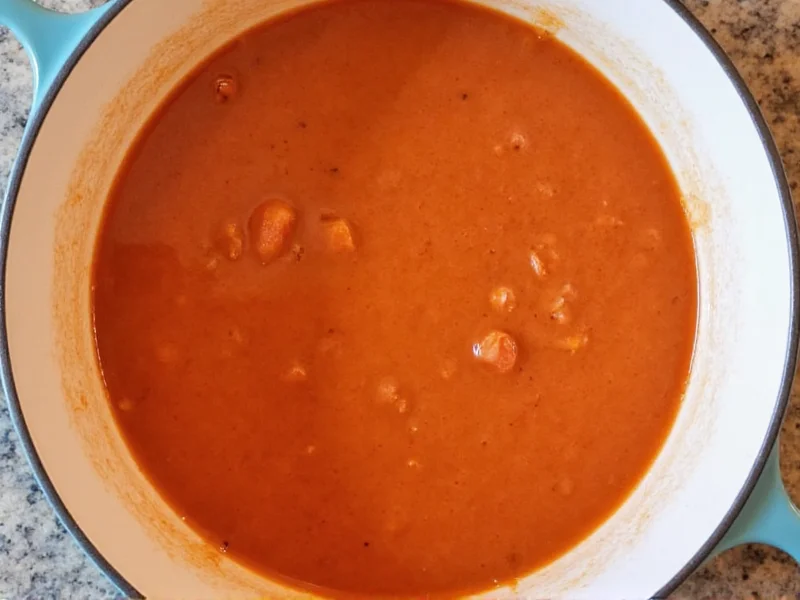Creating exceptional tomato soup from scratch is simpler than most home cooks realize. This foundational recipe delivers a rich, velvety texture with balanced acidity and natural sweetness that surpasses store-bought versions. Whether you're using fresh summer tomatoes or quality canned varieties, the key lies in proper technique and ingredient ratios that transform basic components into a restaurant-quality dish.
Essential Ingredients for Perfect Tomato Soup
Quality ingredients form the foundation of exceptional tomato soup. While variations exist, these core components deliver consistent results:
| Ingredient | Quantity | Notes |
|---|---|---|
| Ripe tomatoes or canned whole peeled tomatoes | 2 lbs fresh or 2 (28-oz) cans | San Marzano varieties preferred for canned; vine-ripened for fresh |
| Yellow onion | 1 medium, diced | Yellow provides better flavor balance than white onions |
| Garlic | 2-3 cloves, minced | Fresh is essential—avoid pre-minced varieties |
| Olive oil | 2 tbsp | Extra virgin for finishing, regular for cooking |
| Vegetable broth | 2 cups | Low-sodium to control seasoning |
| Fresh basil | 1/4 cup chopped | Add at the end for brightest flavor |
| Balsamic vinegar | 1-2 tsp | Essential for balancing sweetness |
Equipment Checklist
You don't need specialized equipment for this easy homemade tomato soup recipe:
- 4-quart heavy-bottomed pot (prevents scorching)
- Immersion blender or regular blender
- Wooden spoon
- Sharp chef's knife
- Box grater (optional for fresh tomatoes)
Step-by-Step Preparation Guide
Follow these professional techniques for the best tomato soup from fresh ingredients:
1. Prepare Your Tomatoes
If using fresh tomatoes, score an "X" on the bottom of each, blanch in boiling water for 30 seconds, then transfer to ice water. Peel off skins and roughly chop. For canned tomatoes, simply drain liquid into a separate container (you may need it later).
2. Build Your Flavor Base
Heat olive oil in your pot over medium heat. Add onions and a pinch of salt, cooking until translucent (about 5 minutes). Add garlic and cook for 1 minute until fragrant—be careful not to burn. This foundational step for creamy tomato soup without cream develops essential flavor compounds.
3. Simmer to Perfection
Add tomatoes (with their liquid if using canned), broth, and a pinch of red pepper flakes. Bring to a gentle simmer, then reduce heat to low. Partially cover and cook for 25-30 minutes, stirring occasionally. The soup is ready when tomatoes have broken down completely and flavors have melded.
4. Blend and Finish
Remove from heat and blend with an immersion blender until completely smooth (or carefully transfer to a regular blender in batches). Return to low heat and stir in fresh basil, balsamic vinegar, and salt to taste. The vinegar is crucial for how to make tomato soup from canned tomatoes taste fresh and balanced.
Pro Tips for Restaurant-Quality Results
Elevate your classic tomato soup recipe with these chef-tested techniques:
- Acidity balance: Always finish with a splash of acid—balsamic or sherry vinegar works better than lemon for depth
- Texture control: If soup is too thick, use reserved tomato liquid rather than additional broth
- Flavor layering: Add a Parmesan rind during simmering for umami depth (remove before blending)
- Temperature matters: Never boil tomato soup after adding acid—it can make tomatoes taste bitter
- Fresh herb timing: Add delicate herbs like basil only at the end to preserve their bright flavor
Variations for Different Dietary Needs
Adapt this basic recipe for various preferences while maintaining excellent flavor:
Creamy Version (Without Dairy)
For a dairy-free creamy tomato soup, blend in 1/4 cup raw cashews that have been soaked for 4 hours, or add 1/2 cup cooked white beans before blending. Both options create luxurious texture without masking the tomato flavor.
Roasted Tomato Variation
For deeper flavor in your tomato soup with fresh herbs, toss 3 lbs halved tomatoes with 2 tbsp olive oil, 1 sliced onion, and 4 garlic cloves. Roast at 400°F (200°C) for 35 minutes until caramelized, then proceed with the recipe. This method works exceptionally well for how to make tomato soup from fresh tomatoes at peak season.
Spicy Arrabbiata Style
Add 1-2 tsp crushed red pepper flakes with the garlic and finish with fresh parsley instead of basil for a bold Italian-inspired version. This variation demonstrates how long to cook tomato soup with additional ingredients without losing freshness.
Storage and Reheating Instructions
Proper storage maintains quality for this healthy tomato soup recipe:
- Refrigeration: Store in airtight container for up to 5 days
- Freezing: Freeze in portion-sized containers for up to 3 months (thaw overnight in refrigerator)
- Reheating: Warm gently over medium-low heat, stirring frequently. Never boil, as this can cause separation and bitterness
- Revitalizing: Add a splash of fresh broth and re-season when reheating, as flavors concentrate during storage
Troubleshooting Common Issues
Solve these frequent tomato soup problems with professional solutions:
Soup Tastes Too Acidic
Add 1/4 tsp baking soda (dissolved in 1 tbsp water) to neutralize excess acid without adding sweetness. Alternatively, a small grated carrot cooked with the onions can balance acidity naturally in your classic tomato soup recipe.
Soup Lacks Depth
Stir in 1 tsp tomato paste with the onions during the initial cooking phase, allowing it to caramelize slightly before adding liquids. This technique builds complexity in how to make tomato soup from canned tomatoes, which sometimes lack depth.
Soup Is Too Watery
Create a slurry with 1 tbsp cornstarch and 2 tbsp cold water, then whisk into simmering soup. Alternatively, simmer uncovered for 10-15 minutes to reduce and concentrate flavors in your easy homemade tomato soup recipe.











 浙公网安备
33010002000092号
浙公网安备
33010002000092号 浙B2-20120091-4
浙B2-20120091-4